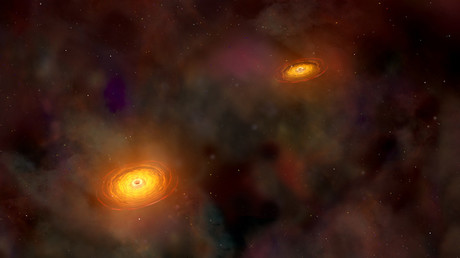The GW170817 event reported by scientists of LIGO (Laser Interferometer Gravitational-Wave Observatory) earlier this year is considered one of this year’s most significant events in astronomy. The gravitational waves detected by LIGO stations coincided with electromagnetic radiation of a wide spectrum, which confirmed that the event causing the waves was a collision of two neutron stars.
READ MORE: Spectacular neutron star crash stretched space time by fraction of an inch (VIDEOS)
Superdense neutron stars are produced following a supernova, while a collision event between two neutron stars is called a ‘kilonova.’ Further research of the now-famous kilonova, which was observed in August, indicates that the remnant of this merger is most likely a black hole rather than a more massive neutron star.
Researchers from Trinity University in Texas, the University of Texas at Austin, and Eureka Scientific analyzed data from the Chandra X-ray Observatory to determine what happened after the collision. The data was obtained on December 3 and 6, 2017 – 108 days after the event.
The results indicate that radio and X-ray emissions were produced at the same source, and that the rising light-curve that followed the merger was likely due to an increase in accelerated charged particles in the external shock.
This could be explained either by a more massive neutron star being formed from the merger, or a black hole, according to the scientists.
“We show next that if the merged object were a hyper-massive neutron star endowed with a strong magnetic field, then the X-ray luminosity associated with the dipole radiation would be larger than the observed luminosity 10 days after the event, but much smaller than the observed flux at t ~ 100 days. This argues against the formation of a hyper-massive neutron star in this merger,” the study stated.
Earlier X-ray data also allowed scientists to rule out the theory that the object was a neutron star, leading them to conclude that “the merged object was most likely a black hole.”
The LIGO project revealed to the world at the start of 2016 that it had detected gravitational waves, confirming Einstein’s Theory of Relativity more than 100 years on.
Source Article from https://www.rt.com/news/414098-gravitational-waves-black-hole/?utm_source=rss&utm_medium=rss&utm_campaign=RSS
Related posts:
Views: 0
 RSS Feed
RSS Feed

















 December 24th, 2017
December 24th, 2017  Awake Goy
Awake Goy 
 Posted in
Posted in  Tags:
Tags: 
















